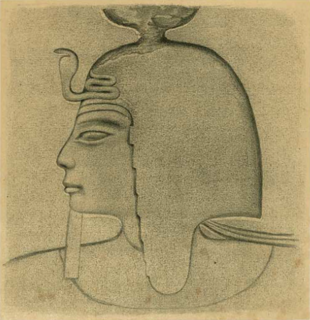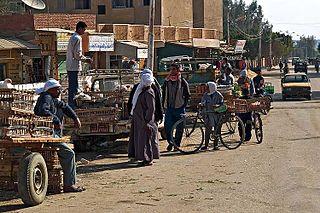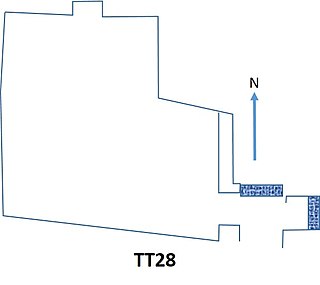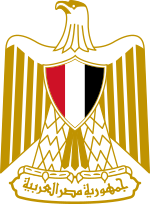
Zahi Hawass is an Egyptian archaeologist, Egyptologist, and former Minister of State for Antiquities Affairs. He has also worked at archaeological sites in the Nile Delta, the Western Desert, and the Upper Nile Valley.

The Supreme Council of Antiquities (SCA) was a department within the Egyptian Ministry of Culture from 1994 until January 2011, when it became an independent ministry, the Ministry of State for Antiquities (MSA). It was the government body responsible for the conservation, protection and regulation of all antiquities and archaeological excavations in Egypt.

Userkhaure-setepenre Setnakhte was the first pharaoh (1189 BC–1186 BC) of the Twentieth Dynasty of the New Kingdom of Egypt and the father of Ramesses III.

El-Wahat el-Bahariya or el-Bahariya is a depression and oasis in the Western Desert of Egypt. It is approximately 370 km away from Cairo. The roughly oval valley extends from northeast to southwest, has a length of 94 km, a maximum width of 42 km and covers an area of about 2000 km².

The Cabinet of Egypt is the chief executive body of the Arab Republic of Egypt. It consists of the Prime Minister and the cabinet ministers.

The Statue of Ramesses II is a 3,200-year-old figure of Ramesses II, depicting him standing. It was discovered in 1820 by Giovanni Battista Caviglia at the Great Temple of Ptah near Memphis, Egypt. It is made from red granite.
Bassam El Shammaa is a researcher in Egyptology and senior tour guide.

The ancient Egyptian noble Pabasa was chief steward of the God's Wife of Amun Nitocris I during the Saite Period. He is buried in tomb TT279, which is located in the El-Assasif, part of the Theban Necropolis, near Thebes.

Sarah Helen Parcak is an American archaeologist, Egyptologist, and remote sensing expert, who has used satellite imaging to identify potential archaeological sites in Egypt, Rome, and elsewhere in the former Roman Empire. She is a professor of Anthropology and director of the Laboratory for Global Observation at the University of Alabama at Birmingham. In partnership with her husband, Greg Mumford, she directs survey and excavation projects in the Faiyum, Sinai, and Egypt's East Delta.

The Ministry of Awqaf of Egypt is one of ministries in the Egyptian government and is in charge of religious endowments. Religious endowments, awqaf, are similar to common law trusts where the trustee is the mosque or individual in charge of the waqf and the beneficiary is usually the community as a whole. Examples of waqfs are of a plot of land, a market, a hospital, or any other building that would aid the community.

Nefermaat I was an ancient Egyptian prince, a son of king Sneferu. He was a vizier possessing the titles of the king's eldest son, royal seal bearer, and prophet of Bastet. His name means "Maat is beautiful" or "With perfect justice".
Behenu was an ancient Egyptian queen of the Sixth Dynasty. She is thought to have been the wife of either Pepi I or of Pepi II.

The Maimonides Synagogue, also known as the Rav Moshe Synagogue, is a historic synagogue located in Cairo, Egypt. A synagogue has existed at the site since the 10th century and was subsequently named after the famous Jewish philosopher, rabbi and physician Maimonides, after his arrival there in around 1168. It is believed that Maimonides' original tomb is contained within the building. In March 2010, the Egyptian government completed the restoration of the current building which dates from the late 19th century.

The Theban Tomb TT28 is located in El-Assasif. It forms part of the Theban Necropolis, situated on the west bank of the Nile opposite Luxor. The tomb is the burial place of the Ancient Egyptian official, Hori.

Smart Village is a high-technology business district in the city of 6th of October, Egypt, established by Presidential Decree no.355 in 2000, with activities starting in 2001. It is located on the Cairo-Alexandria Desert Road, slightly west of Cairo. Smart Village occupies an area of 450 feddans. It's a business district with office buildings, retail shops, entertainment, factories and green spaces.

Tutankhamun's trumpets are a pair of trumpets found in the burial chamber of the Eighteenth Dynasty Pharaoh Tutankhamun. The trumpets, one of sterling silver and one of bronze or copper, are considered to be the oldest operational trumpets in the world, and the only known surviving examples from ancient Egypt.
Mohamed Saber Ibrahim Arab is a veteran politician, who has served as Egypt's former minister of culture in different cabinets, including the Beblawi cabinet.
Mamdouh Mohamed Gad Eldamaty is an Egyptian Egyptologist who has served in the government of Egypt as Minister of Antiquities from 2014 until 2016. He has also worked as Professor of Egyptology at the Department of Archaeology, Faculty of Arts, Ain Shams University in Cairo. On 15 May 2011, he became Cultural Counselor and Head of the Educational Mission at the Embassy of Egypt in Berlin. On 16 June 2014 it was announced that he was to be appointed as Minister of Antiquities, a position he held until March 2016 when he was replaced by Khaled El-Anany after a cabinet reshuffle.
The National Museum of Egyptian Civilization (NMEC) is a large museum in the ancient city of Fustat, now part of Cairo, Egypt. The museum partially opened in February 2017 and will display a collection of 50,000 artefacts, presenting Egyptian civilization from prehistoric times to the present day.

Mostafa Kemal Madbouly is the current Prime Minister of Egypt. He was appointed by President Abdel Fattah el-Sisi to succeed Sherif Ismail following his government's resignation in the wake of Sisi's re-election. Madbouly also serves in the Egyptian Government as Minister of Housing and Urban Utilities, and has also briefly served as interim Prime Minister.














